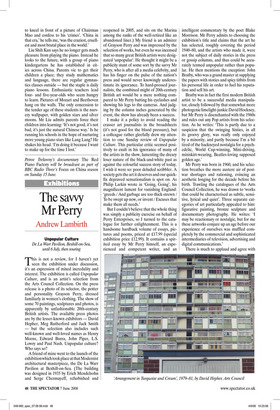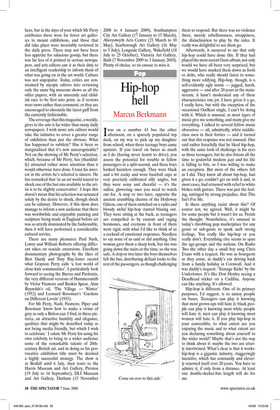The savvy Mr Perry
Andrew Lambirth
Unpopular Culture De La Warr Pavilion, Bexhill-on-Sea, until 6 July, then touring This is not a review, for I haven’t yet seen the exhibition under discussion, it’s an expression of mixed incredulity and interest. The exhibition is called Unpopular Culture, and is an artist’s selection from the Arts Council Collection. On the press release is a photo of its selector, the potter and personality Grayson Perry, dressed familiarly in women’s clothing. The show of some 70 paintings, sculptures and photos, is apparently by unfashionable 20th-century British artists. The available press photos are by the lesser-known exhibitors — David Hepher, Meg Rutherford and Jack Smith — but the selection also includes such well-known and well-loved names as Henry Moore, Edward Burra, John Piper, L.S. Lowry and Paul Nash. Unpopular culture? Who says so?
A friend of mine went to the launch of the exhibition which took place at that Modernist architectural masterpiece, the De La Warr Pavilion at Bexhill-on-Sea. (The building was designed in 1935 by Erich Mendelsohn and Serge Chermayeff, refurbished and reopened in 2005, and sits on the Marina among the ranks of the well-retired like an abandoned liner.) My friend is an admirer of Grayson Perry and was impressed by the selection of works, but even he was incensed that so many great British artists were designated ‘unpopular’. He thought it might be a publicity stunt of some sort by the savvy Mr Perry, who is after all a media celebrity, and has his finger on the pulse of the nation’s press and would never knowingly underestimate its ignorance. To hard-pressed journalists, the combined might of 20th-century British art would be a mere nothing compared to Mr Perry batting his eyelashes and showing his legs to the cameras. And judging by the column inches generated by the event, the show has already been a success.
I make it a policy to avoid reading the crasser art journalists in the broadsheets (it’s not good for the blood pressure), but a colleague rather gleefully drew my attention to one Sunday review of Unpopular Culture. This particular critic seemed positively to exult in his ignorance of many of the artists in the show, lamenting the dreary loser nature of the black-and-white past as against the colourful success story of today. I wish it were so: poor deluded scribbler. A society gets the art it deserves and our quickfix depraved sensationalism is spot on. As Philip Larkin wrote in ‘Going, Going’, his magnificent lament for vanishing England: ‘greeds / And garbage are too thick-strewn / To be swept up now, or invent / Excuses that make them all needs.’ But I couldn’t believe that the whole thing was simply a publicity exercise on behalf of Perry Enterprises, so I turned to the catalogue for further enlightenment. This is a handsome hardback volume of essays, pictures and poems, priced at £17.99 (special exhibition price £12.99). It contains a spirited essay by Mr Perry himself, an experienced and competent writer, and an intelligent commentary by the poet Blake Morrison. Mr Perry admits to choosing the exhibition’s title and claims that the art he has selected, roughly covering the period 1940–80, and the artists who made it, were not the subject of daily stories in the press or gossip columns, and thus could be accurately termed unpopular rather than popular. He then mentions the exception: John Bratby, who was a grand master at supplying the papers with stories and spicy titbits from his personal life in order to fuel his reputation and sell his art.
Bratby was in fact the first modern British artist to be a successful media manipulator, closely followed by that somewhat more photogenic limelight-junkie David Hockney, but Mr Perry is disenchanted with the 1960s and rules out any Pop artists from his selection. As he writes: ‘This is partly due to a suspicion that the swinging Sixties, in all its groovy glory, was really only enjoyed by a minority, and partly because I’m a bit tired of the hackneyed nostalgia for a psychedelic, World Cup-winning, Mini-driving, miniskirt-wearing, Beatles-loving supposed golden age.’ Mr Perry was born in 1960, and his selection breathes the more austere air of postwar shortages and rationing, evincing an aesthetic longing for the decade before his birth. Trawling the catalogues of the Arts Council Collection, he was drawn to ‘works that could be characterised as subtle, sensitive, lyrical and quiet’. Three separate categories of art particularly appealed to him: figurative painting, bronze sculpture and documentary photography. He writes: ‘I may be reactionary or nostalgic, but for me these artworks conjure up an age before our experience of ourselves was muffled completely by the commercial and sophisticated intermediaries of television, advertising and digital communications.’ There is much to applaud and agree with here, but in the days of yore which Mr Perry celebrates there were far fewer art galleries to mount exhibitions, and those that did take place were invariably reviewed in the daily press. There may not have been less appetite for salacious gossip, but there was far less of it printed in serious newspapers, and arts editors saw it as their duty to an intelligent readership to inform them of what was going on in the art world. Culture was not unpopular. Today, critics are constrained by myopic editors into reviewing only the same big museum shows as all the other papers, with an unseemly and childish race to be first into print, as if reviews were news rather than comment; or they are encouraged to chronicle the latest guff from the currently fashionable.
The coverage that this magazine, a weekly, gives to the arts is far wider than many daily newspapers. I wish more arts editors would take the initiative to cover a greater range of exhibition than just the obvious. What has happened to subtlety? Has it been so marginalised that it’s now unrecognisable? Not on the showing of Mr Perry’s selection, which, because of Mr Perry, has (thankfully) attracted rather more attention than it would otherwise have done. I trust his interest in the artists he’s selected is sincere. He has remarked that ‘in an art world inured to shock one of the last sins available to the artist is to be slightly conservative’. I hope this doesn’t mean that his selection was actuated solely by the desire to shock, though shock can be salutary. However, if this show does manage to inform a new audience that there was worthwhile and enjoyable painting and sculpture being made in England before art was so utterly dominated by the fashionable, then it will have performed a considerable cultural service.
There are many pleasures: Paul Nash, Lowry and William Roberts offering different takes on seaside excursions. Excellent documentary photographs by the likes of Bert Hardy and Tony Ray-Jones record what Grayson Perry calls ‘a lost world of close-knit communities’. I particularly look forward to seeing the Burras and Paolozzis, the very different versions of Hammersmith by Victor Pasmore and Ruskin Spear, Alan Reynolds’s oil, ‘The Village — Winter’ (1952) and Leonard Rosoman’s ‘Gardens on Different Levels’ (1955).
For Mr Perry, Nash, Pasmore, Piper and Rosoman ‘know how to make a virtue of grey as only a Briton can. I find, in these pictures, an attractive humility and elegance, qualities that might be described today as not being media friendly, but which I wish to celebrate.’ I salute Mr Perry for using his own celebrity to bring to a wider audience some of the remarkable talents of 20thcentury British art, and in doing so his provocative exhibition title must be deemed a highly successful strategy. The show is at Bexhill until 6 July, then tours to the Harris Museum and Art Gallery, Preston (19 July to 14 September), DLI Museum and Art Gallery, Durham (15 November 2008 to 4 January 2009), Southampton City Art Gallery (17 January to 15 March), Aberystwyth Arts Centre (21 March to 10 May), Scarborough Art Gallery (16 May to 5 July), Longside Gallery, Wakefield (18 July to 25 October), Victoria Art Gallery, Bath (7 November 2009 to 3 January 2010). Plenty of choice, so no excuse to miss it.











































































 Previous page
Previous page